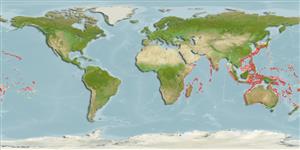Classification / Names
Common names | Synonyms | Catalog of Fishes (gen., sp.) | ITIS | CoL | WoRMS | Cloffa
Actinopterygii (ray-finned fishes) >
Perciformes (Perch-likes) >
Serranidae (Sea basses: groupers and fairy basslets) > Epinephelinae
Environment / Climate / Range
Ecology
Marine; bathydemersal; depth range 150 - 300 m (Ref. 5222). Deep-water, preferred ?; 44°N - 39°S, 29°E - 136°W (Ref. 5222)
Indo-West Pacific: Somalia and South Africa to Japan, Australia and New Zealand. Except for Japan, China, and Korea, most distribution records for Epinephelus septemfasciatus are probably based on this species. Reported as Epinephelus compressus by Postel et al. (Ref. 6453).
Size / Weight / Age
Maturity: Lm ? range ? - ? cm
Max length : 130 cm TL male/unsexed; (Ref. 4787); max. published weight: 80.0 kg (Ref. 4787); max. reported age: 43 years (Ref. 92312)
Dorsal
spines
(total): 11;
Dorsal
soft rays
(total): 14-15;
Anal
spines: 3;
Anal
soft rays: 9. Distinguished by the following characteristics: body buff with 8 broad dark brown bars; blackish brown pelvic fins and distal half of the soft dorsal and anal fins; faint dark band from eye to the middle opercle spine; presence of blackish maxillary streak; minute melanophores covering gill rakers and gill arches; depth of body contained 2.2-2.7 times in SL; head length 2.4-2.5 times in SL; distinctly convex interorbital area, convex dorsal head profile; angular preopercle, enlarged serrae at angle; 0-3 small spines at lower edge of preopecle anterior to angle; distinctly serrate lower edge of subopercle and rear edge of interopercle; convex upper edge of operculum; posterior nostrils 2-3 times larger than anterior nostrils; maxilla reaches to below rear half of eye (Ref. 89707).
Probably occurs in rocky reefs. Its apparent rarity may be due to its preference for relatively deep water.
Life cycle and mating behavior
Maturity | Reproduction | Spawning | Eggs | Fecundity | Larvae
Craig, M.T. and P.A. Hastings, 2007. A molecular phylogeny of the groupers of the subfamily Epinephelinae (Serranidae) with revised classification of the epinephelini. Ichthyol. Res. 54:1-17. (Ref. 83414)
IUCN Red List Status (Ref. 115185)
CITES (Ref. 94142)
Not Evaluated
Threat to humans
Reports of ciguatera poisoning (Ref. 30302)
Human uses
Fisheries: minor commercial
More information
Common namesSynonymsMetabolismPredatorsEcotoxicologyReproductionMaturitySpawningFecundityEggsEgg development
ReferencesAquacultureAquaculture profileStrainsGeneticsAllele frequenciesHeritabilityDiseasesProcessingMass conversion
Tools
Special reports
Download XML
Internet sources
